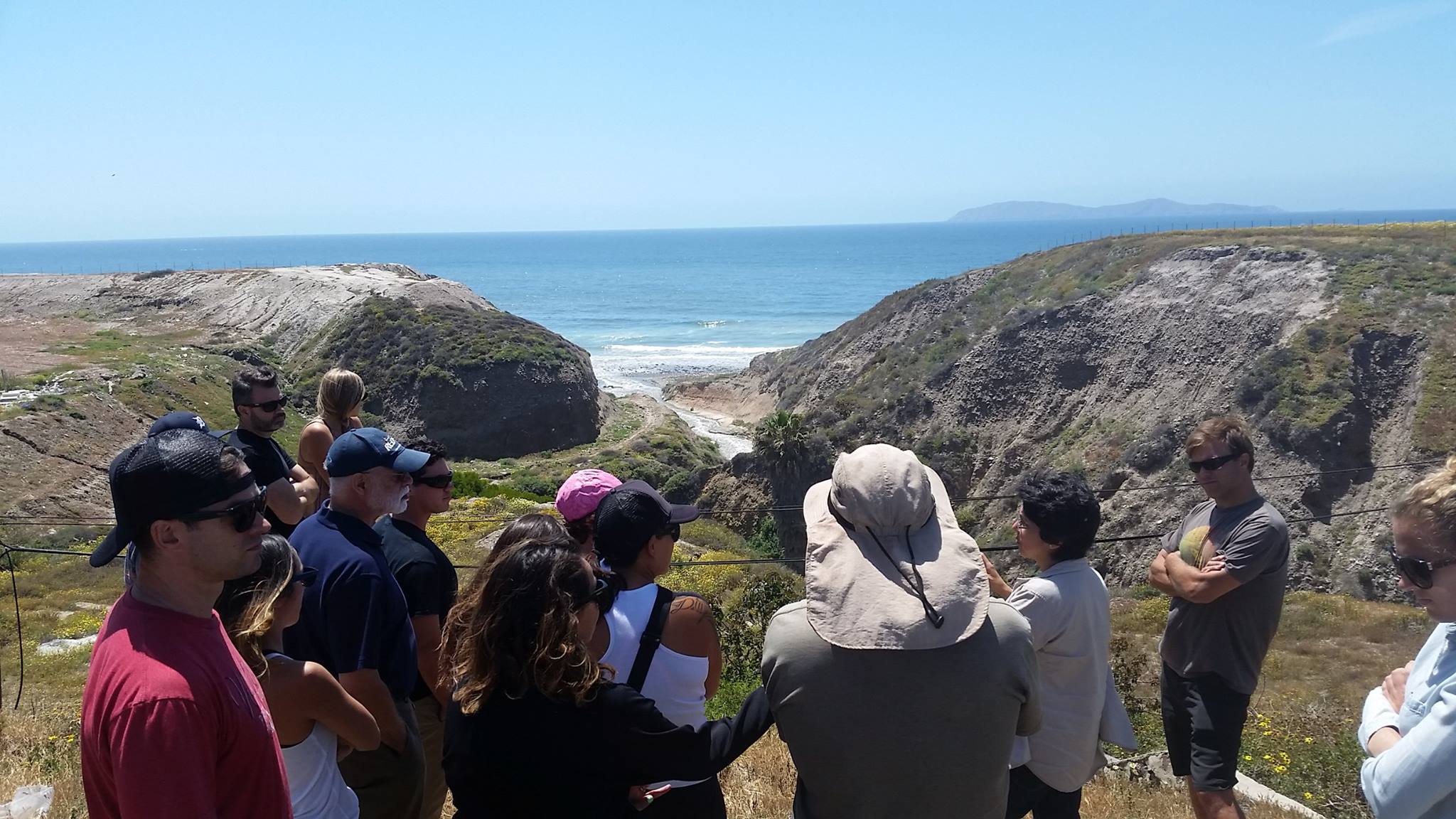

By Al Valentin
On Friday, April 22nd members of the No Border Sewage (NoBS) committee embarked on a two day educational adventure to Baja California, Mexico. The objectives of this trip was to tour the Tijuana River Watershed, explore sources of sewage and waste that flows into the ocean, and learn from our neighbors to the south regarding their wastewater treatment system.
After loading up passengers and supplies into two white E350 vans, we started south toward the San Ysidro Border Crossing. The border crossing was relatively painless - the passenger van piloted by Roger was stopped momentarily for visual inspection. However, the boards/bags van, piloted by Jose and Cheryl, was subjected to a thorough search by the the larger than life X-Ray machine. After being cleared, we continued south toward Puerta Del Mar which is about 55 km south of the border. Along the way we made stop in Primo Tapia for the best street tacos I think any of us had ever tasted. With full bellies and large smiles we retired for the night at Roger, Mario and Noel’s beach homes.
After rising early Saturday morning we again loaded up the vans and headed north to Playas to pick up our guide and guest speaker Margarita Diaz. Margarita,the Director of Proyecto Fronterizo de Educación Ambiental (PFEA) has been spearheading the green movement in Baja for 25 years to protect and preserve the Tijuana watershed, beaches and ocean. Margarita is intimately familiar with the issues and has been a spokesperson for the movement for over 23 years. After picking up Margarita, we headed to the border again to pick a few more members of the committee and some members of the International Boundary and Water Commission Citizens Forum. From there we headed east to one of the ecological preserves Margarita helped establish, Arroyo Alamar. On the way there we passed a semi- permanent squatters village lining the Tijuana River. The domiciles were made of cardboard, border fence panels, and had plastic banners as roofs. The poverty is overwhelming. Smoldering tires and trash heaps dotted the landscape.Due to the lack sufficient permanent infrastructure the biological waste and garbage of the inhabitants ends up in the TJ River. When we made our first stop on the tour, Margarita explained how the Tijuana river serpentines across the border several times and actually originates on the US side of the Border. The U.S. has dammed the river in two locations which has changed the ecology of the area due to inconsistent waterflow. During rainy seasons, the river would often flood into neighboring streets. In response, Tijuana water officials decided to build concrete channels in order to better control river flow. The PFEA opposed the construction of the channels because they further altered the ecology of the watershed, ultimately destroying natural biofilters. From the dams to the river mouth in the sloughs, human alteration of the Tijuana watershed has eased the path of wastewater into our ocean.
Our second stop of the tour was in the valley below a secondary water treatment plant on the south side of the river. The plant sanitizes the water it process to level two purity, meeting American EPA standards, and is one of two built in the last decade. The regional Mexican government borrowed the money from the Japanese government to build five such plants throughout Baja. Unfortunately there is speculation as to the availability funds to complete the remaining three plants.
After leaving the valley below the plant we crossed the river and drove to Ecoparque, a bio water filter project responsible for filtering the water and waste from 350 homes. The project uses a series of towers to filter out hard waste using only gravity to move the water. The volume of water and success of the project was incredible.
Our final stop of the tour was on the side of the road in Baja Del Mar. Where we stopped was located downstream from the second treatment plant. What we witnessed here was more shocking than all the garbage and sewage we saw the whole trip trickling through the TJ river in the city of Tijuana. A brown river pumping thousands of gallons a minute of incorrectly treated raw sewage raged down the hillside into a gully that poured out into the ocean. A massive brown discoloration in the water extended approximately a quarter mile north and south of the outlet, and about 500 yards west of it. Margarita advised the group that the PFEA has done testing in the area and the bacteria levels are measured in the thousands, while safe levels are in single digits. The PFEA has tried to bring attention to the matter but plant representatives do not acknowledge the testing data and claim the plant is operating efficiently. It is clear to the naked eye that water coming out of the plant is still contaminated with solid waste. The group as a whole was in utter disbelief and shock.
With all of the locations that we visited, and all the information that Margarita gave the group it is clear that the border sewage issue is not a localized problem. There are many varying shades of grey, blame and responsibility can not be placed on one government or the other. To solve the issue organizations and governments on both sides of the border need to work together to reach the ultimate goal of clean usable river valleys and beaches.
